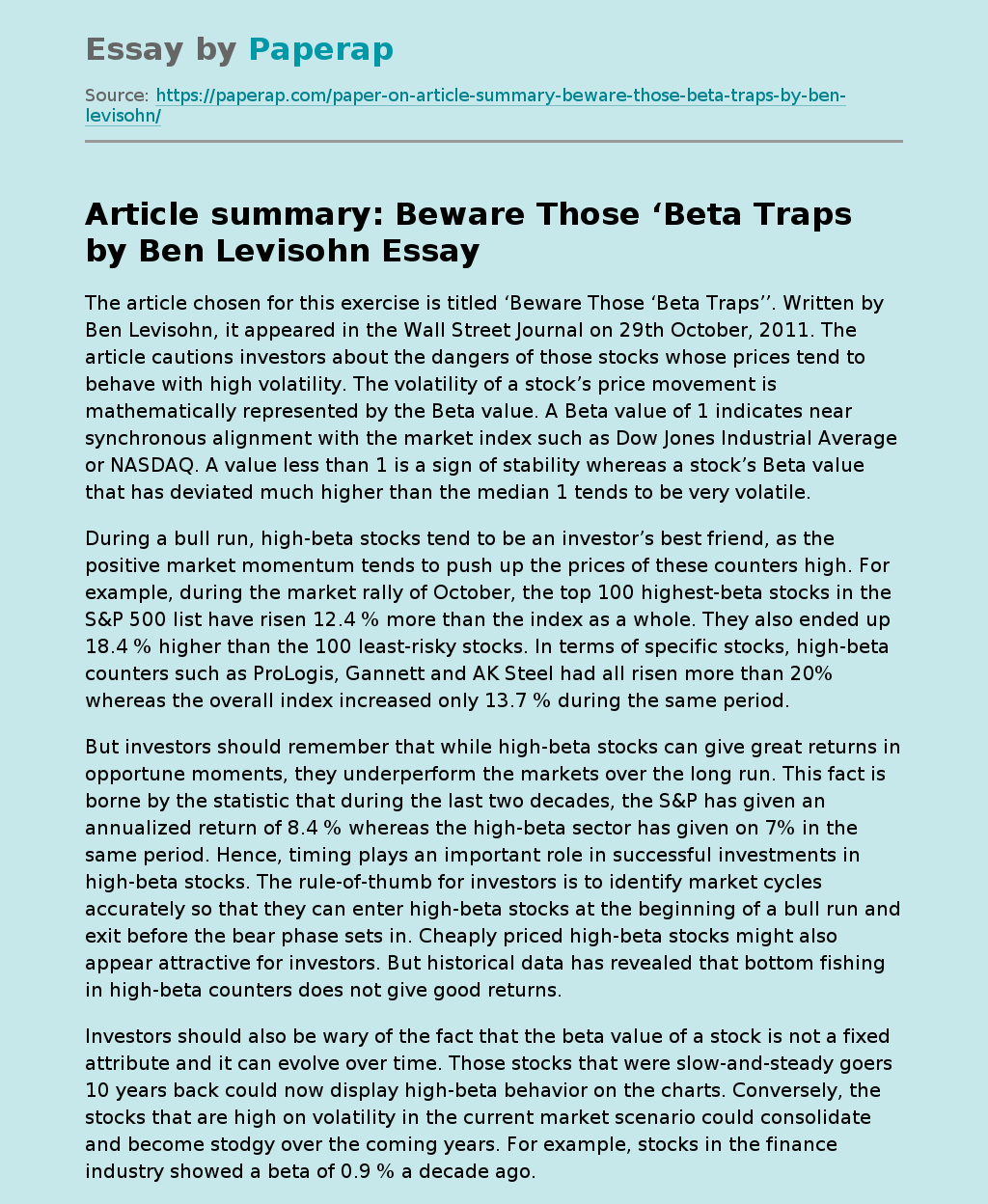Beware Those Beta Traps by Ben Levisohn
The following essay sample is a summary of the article: Beware of Ben Levison’s beta traps. Read the introduction, body and conclusion of the essay, scroll down.
The article chosen for this exercise is titled ‘Beware Those ‘Beta Traps’’. Written by Ben Levisohn, it appeared in the Wall Street Journal on 29th October, 2011. The article cautions investors about the dangers of those stocks whose prices tend to behave with high volatility. The volatility of a stock’s price movement is mathematically represented by the Beta value.
A Beta value of 1 indicates near synchronous alignment with the market index such as Dow Jones Industrial Average or NASDAQ. A value less than 1 is a sign of stability whereas a stock’s Beta value that has deviated much higher than the median 1 tends to be very volatile.
During a bull run, high-beta stocks tend to be an investor’s best friend, as the positive market momentum tends to push up the prices of these counters high.
For example, during the market rally of October, the top 100 highest-beta stocks in the S&P 500 list have risen 12.4 % more than the index as a whole. They also ended up 18.4 % higher than the 100 least-risky stocks. In terms of specific stocks, high-beta counters such as ProLogis, Gannett and AK Steel had all risen more than 20% whereas the overall index increased only 13.7 % during the same period.
But investors should remember that while high-beta stocks can give great returns in opportune moments, they underperform the markets over the long run.
This fact is borne by the statistic that during the last two decades, the S&P has given an annualized return of 8.4 % whereas the high-beta sector has given on 7% in the same period. Hence, timing plays an important role in successful investments in high-beta stocks. The rule-of-thumb for investors is to identify market cycles accurately so that they can enter high-beta stocks at the beginning of a bull run and exit before the bear phase sets in. Cheaply priced high-beta stocks might also appear attractive for investors. But historical data has revealed that bottom fishing in high-beta counters does not give good returns.
Investors should also be wary of the fact that the beta value of a stock is not a fixed attribute and it can evolve over time. Those stocks that were slow-and-steady goers 10 years back could now display high-beta behavior on the charts. Conversely, the stocks that are high on volatility in the current market scenario could consolidate and become stodgy over the coming years. For example, stocks in the finance industry showed a beta of 0.9 % a decade ago. The value has now risen to 1.6. Similarly, while utilities stocks tended to show low beta (0.12 a decade back), they have now risen to 0.46. The number of consumer-discretionary and energy stocks in the high-beta small cap segment has also increased in the last 5 years.
Hence picking stocks with high-beta track record is a risky activity. Investors should conduct comprehensive research to assure themselves of reasonable future earnings in the stocks they want to invest. The better stocks always demand a ‘scarcity premium’, which the prudent investor must be willing to pay. There are also divergences in the characteristics of stocks from different industries, which an intelligent investor could take advantage of. For example, the materials sector is more likely to outperform the markets compared to the financial sector.
The article chosen for this exercise is titled ‘Beware Those ‘Beta Traps’’. Written by Ben Levisohn, it appeared in the Wall Street Journal on 29th October, 2011. The article cautions investors about the dangers of those stocks whose prices tend to behave with high volatility. The volatility of a stock’s price movement is mathematically represented by the Beta value. A Beta value of 1 indicates near synchronous alignment with the market index such as Dow Jones Industrial Average or NASDAQ. A value less than 1 is a sign of stability whereas a stock’s Beta value that has deviated much higher than the median 1 tends to be very volatile.
During a bull run, high-beta stocks tend to be an investor’s best friend, as the positive market momentum tends to push up the prices of these counters high. For example, during the market rally of October, the top 100 highest-beta stocks in the S&P 500 list have risen 12.4 % more than the index as a .
Beware Those Beta Traps by Ben Levisohn. (2019, Feb 23). Retrieved from https://paperap.com/paper-on-article-summary-beware-those-beta-traps-by-ben-levisohn/

